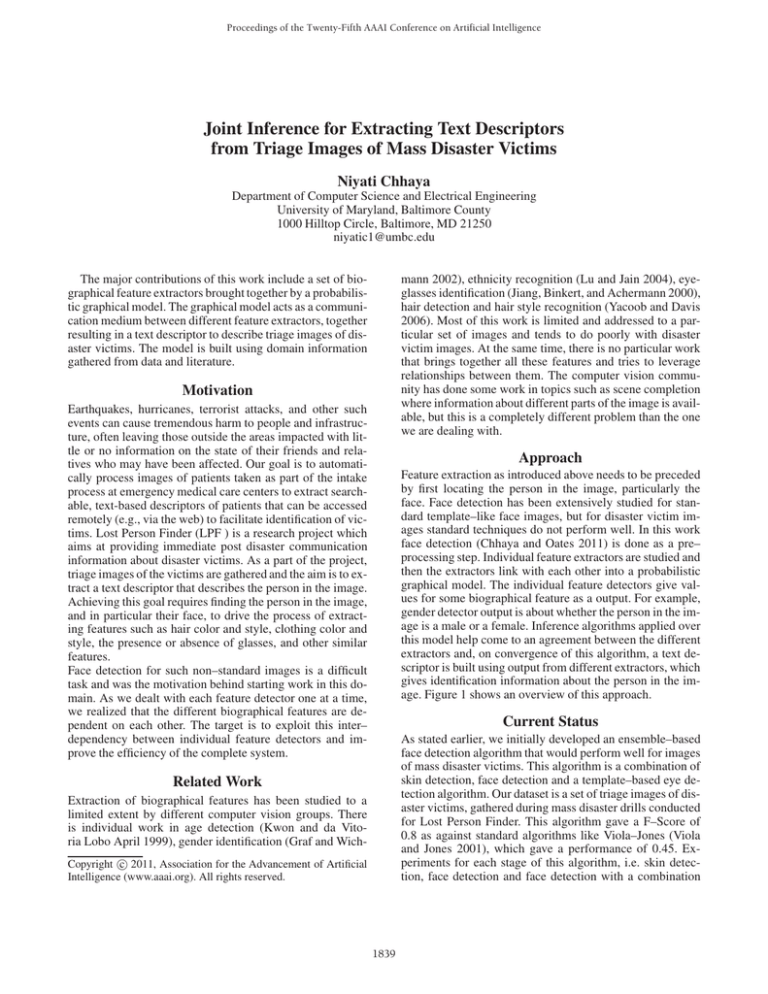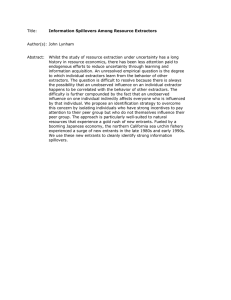
Proceedings of the Twenty-Fifth AAAI Conference on Artificial Intelligence
Joint Inference for Extracting Text Descriptors
from Triage Images of Mass Disaster Victims
Niyati Chhaya
Department of Computer Science and Electrical Engineering
University of Maryland, Baltimore County
1000 Hilltop Circle, Baltimore, MD 21250
niyatic1@umbc.edu
mann 2002), ethnicity recognition (Lu and Jain 2004), eyeglasses identification (Jiang, Binkert, and Achermann 2000),
hair detection and hair style recognition (Yacoob and Davis
2006). Most of this work is limited and addressed to a particular set of images and tends to do poorly with disaster
victim images. At the same time, there is no particular work
that brings together all these features and tries to leverage
relationships between them. The computer vision community has done some work in topics such as scene completion
where information about different parts of the image is available, but this is a completely different problem than the one
we are dealing with.
The major contributions of this work include a set of biographical feature extractors brought together by a probabilistic graphical model. The graphical model acts as a communication medium between different feature extractors, together
resulting in a text descriptor to describe triage images of disaster victims. The model is built using domain information
gathered from data and literature.
Motivation
Earthquakes, hurricanes, terrorist attacks, and other such
events can cause tremendous harm to people and infrastructure, often leaving those outside the areas impacted with little or no information on the state of their friends and relatives who may have been affected. Our goal is to automatically process images of patients taken as part of the intake
process at emergency medical care centers to extract searchable, text-based descriptors of patients that can be accessed
remotely (e.g., via the web) to facilitate identification of victims. Lost Person Finder (LPF ) is a research project which
aims at providing immediate post disaster communication
information about disaster victims. As a part of the project,
triage images of the victims are gathered and the aim is to extract a text descriptor that describes the person in the image.
Achieving this goal requires finding the person in the image,
and in particular their face, to drive the process of extracting features such as hair color and style, clothing color and
style, the presence or absence of glasses, and other similar
features.
Face detection for such non–standard images is a difficult
task and was the motivation behind starting work in this domain. As we dealt with each feature detector one at a time,
we realized that the different biographical features are dependent on each other. The target is to exploit this inter–
dependency between individual feature detectors and improve the efficiency of the complete system.
Approach
Feature extraction as introduced above needs to be preceded
by first locating the person in the image, particularly the
face. Face detection has been extensively studied for standard template–like face images, but for disaster victim images standard techniques do not perform well. In this work
face detection (Chhaya and Oates 2011) is done as a pre–
processing step. Individual feature extractors are studied and
then the extractors link with each other into a probabilistic
graphical model. The individual feature detectors give values for some biographical feature as a output. For example,
gender detector output is about whether the person in the image is a male or a female. Inference algorithms applied over
this model help come to an agreement between the different
extractors and, on convergence of this algorithm, a text descriptor is built using output from different extractors, which
gives identification information about the person in the image. Figure 1 shows an overview of this approach.
Current Status
As stated earlier, we initially developed an ensemble–based
face detection algorithm that would perform well for images
of mass disaster victims. This algorithm is a combination of
skin detection, face detection and a template–based eye detection algorithm. Our dataset is a set of triage images of disaster victims, gathered during mass disaster drills conducted
for Lost Person Finder. This algorithm gave a F–Score of
0.8 as against standard algorithms like Viola–Jones (Viola
and Jones 2001), which gave a performance of 0.45. Experiments for each stage of this algorithm, i.e. skin detection, face detection and face detection with a combination
Related Work
Extraction of biographical features has been studied to a
limited extent by different computer vision groups. There
is individual work in age detection (Kwon and da Vitoria Lobo April 1999), gender identification (Graf and Wichc 2011, Association for the Advancement of Artificial
Copyright Intelligence (www.aaai.org). All rights reserved.
1839
other and so do age and hair color. Figure 2 shows a diagram of this ad–hoc graph. We further developed a factor
graph for this net. We are also working on gathering data to
validate the different edges in the graph and to help define
the domains of different nodes is a more complete manner
using person datasets (Gallagher and Chen 2008) (Berg et
al. 2004) and the Amazon mechanical turk.
#
Future Work
Having defined the graphical model, we are currently working on gathering data to validate the relationships. Another
main task is to define the potential functions that communicate between the adjoining nodes and indicate whether
the nodes agree with each other or not. The potential function will follow the energy minimization concept where the
higher the value of the potential function, the smaller is the
agreement between the nodes. Once the potential function is
established and the different feature detectors are responding
as needed, the next stage will be to have the individual feature detectors learn from the values of the potential function.
If the potential function indicates that there is a disagreement
with an adjoining node, the feature detector should adapt
from information available and change its output if necessary. The final aim is to have the feature extractors agree
with each other and the potential functions to converge at a
minimum value. The output would be an ensemble of values
from different extractors put together in the form of a text
descriptor.
!" #
#
" Figure 1: Project Architecture
References
of skin and eye detection, show that the ensemble performs
best. The next step is addressing the various different feature
extractors. So far, we have done work in eyeglasses detection, hair region detection using a combination of color and
texture analysis, hair color and skin color identification and
preliminary work in ethnicity identification. Preliminary experiments show these developed approaches perform better
than existing algorithms for the given set of images.
The main target of this work is to bring these different
extractors together. We designed an ad–hoc Markov net using information available in the literature. That is, information such as gender and facial hair tend to be related to each
Figure 2: Markov Net
1840
Berg, T. L.; Berg, A. C.; Edwards, J.; and Forsyth, D. A.
2004. Whos in the picture. In NIPS.
Chhaya, N., and Oates, T. 2011. Robust face detection for
patient triage images. In VISAPP 2011- Proceedings of the
Sixth International Conference on Computer Vision Theory
and Applications, to appear. INSTICC Press.
Gallagher, A., and Chen, T. 2008. Clothing cosegmentation
for recognizing people. In Proceeding of CVPR.
Graf, A. B. A., and Wichmann, F. A. 2002. Gender classification of human faces. In Biologically Motivated Computer
Vision 2002, LNCS 2525, 491–501.
Jiang, X.; Binkert, M.; and Achermann, B. 2000. Towards
detection of glasses in facial images. Pattern Analysis Applications 3:9–18.
Kwon, Y. H., and da Vitoria Lobo, N. April 1999. Age classification from facial images. Computer Vision and Image
Understanding 74:1–21.
Lost person finder. http://archive.nlm.nih.gov/proj/lpf.php.
Lu, X., and Jain, A. K. 2004. Ethnicity identification from
face images. In SPIE International Symposium on Defense
and Security : Biometric Technology for Human Identification, 114–123.
Viola, P., and Jones, M. 2001. Robust real-time object detection. In International Journal of Computer Vision.
Yacoob, Y., and Davis, L. S. 2006. Detection and analysis
of hair. IEEE Transactions Pattern Analysis Machine Intelligence 28(7):1164–1169.





